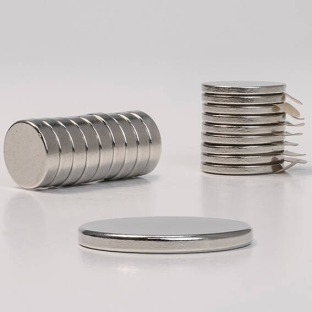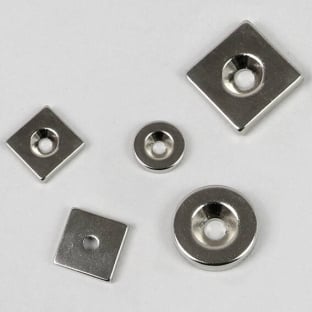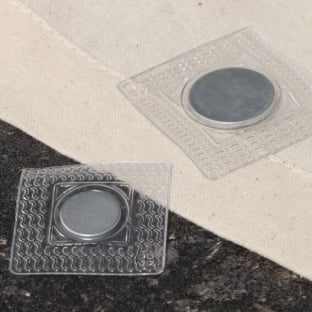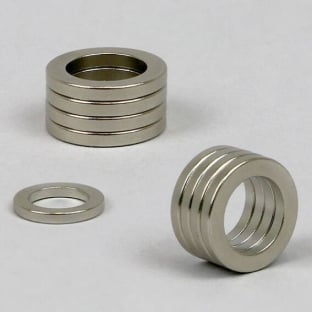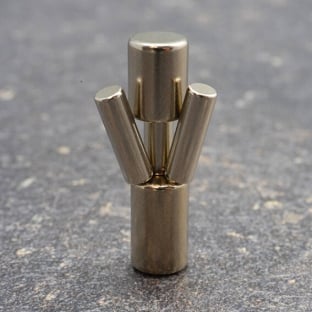Neodymium magnets

Neodymium magnets impress with their strong holding force and minimal volume. They are made of rare earths and neodymium iron boron (NdFeB). Since they require little space, there are countless applications for neodymium magnets. As an example, they are ideal for use as magnetic closures in clothing, accessories or furniture doors. They are also ideally suited as magnets for applications where they are sewed in, screwed on or fixed to metal surfaces. Whether in industry, in a commercial, creative or even private context: Use neodymium magnets whenever you need a high holding power with a small magnet size!
What is a supermagnet?
A neodymium magnet consists of a neodymium iron boron alloy. This alloy ensures that neodymium magnets are among the strongest magnets in terms of magnetic force in relation to volume. In fact, a neodymium magnet can hold up to 2000 times its own weight. For this reason they also carry the name supermagnets. For example, the smallest magnet in our MagnetiQ magnet shop has a diameter and height of only 1 mm with a holding force of 30 grams. The advantages of rare earth magnets:
- Outstanding holding force
- Their small size make them versatile in use
- Small size and low weight
Why are neodymium magnets also called rare-earth magnets?
Neodymium magnets are also referred to as rare-earth magnets, since so-called rare earths are required for their manufacture. The term rare earths is based on the difficult extraction of the material and the costly separation from other compounds, which makes the material usable in the first place.
How are supermagnets produced?
Rare earths and the raw material neodymium iron boron (NdFeB) are required for the production of a neodymium magnet. Since rare earth magnets have a porous core, they cannot be used without further processing. Here the remedy is the coating. Usually a coating of nickel (Ni-Cu-Ni) is used. The optically appealing silver gloss is a side effect of the coating. The cheaper option is a coating with zinc (Zn), which creates a matt, silver-gray colour. Alternatively, coatings can consist of gold, copper or coloured varnish. Different magnetization directions are also possible for the magnets. In our MagnetiQ magnet shop all neodymium magnets are axially magnetized. This means that the poles are on the large surfaces of the magnets.
What is the difference between ferrite magnets and neodymium magnets?
Neodymium magnets are more expensive than ordinary ferrite magnets due to their complex production process and outstanding performance. Depending on the application, our customers often ask themselves whether an allegedly cheaper alternative might be the better option. Due to the special combination of neodymium iron boron (NdFeB), neodymium magnets are much more powerful than their competitors. Even in its smallest dimensions, a supermagnet achieves a holding force that far exceeds that of a ferrite magnet. So if you want a ferrite magnet for the same magnetic force, the magnet must be much larger. A magnet made of neodymium iron boron should therefore always be the first choice when a small, light magnet with a strong holding force is required. Whether ball magnets, stick magnets, ring magnets, disk magnets, block magnets, cube magnets, cone magnets magnets made of neodymium can be used in all conceivable forms due to their magnetization in contrast to alternative magnets.
Where are supermagnets used?
Due to their ultra-strong holding force, the mostly small neodymium magnets are popular little helpers in the office or in the workshop as well as in manufacturing. Whether as magnetic closures, simple attachment option to surfaces without adhesives or screws or the specific use as a workpiece connector neodymium magnets are indispensable in the commercial environment. By combining the two, metals and magnets hold a unique potential for numerous industries. Supermagnets are also used in industries like IT and medical as well as communications technology. Some areas of application include the following:
- Attachment on pinboards, whiteboards, planning boards
- Magnetic name badges
- Magnetic closures
- Holder for workpieces, tools, knives
- Engines
- Injection pumps
- Starters
- Sensors
- Speakers
- Medical equipment
Buy neodymium magnets: Which supermagnets are available in the MagnetiQ magnet shop?
Neodymium magnets are available in different shapes and sizes. In the SPRINTIS MagnetiQ magnet shop you will see a variety of different designs, so you can find the right super magnet for every application. The following versions in various designs can be found in our product range:
- Disc magnets
- Regular versions
- Sew-in magnets
- Block magnets
- Stick magnets
- Ball magnets
- Cube magnets
- Pot magnets
- Ring magnets
- Ufo-disc magnets
- Cone magnets
- Magnets for screw mounting
Self-adhesive neodymium magnets
MagnetiQ offers the largest selection of neodymium self-adhesive magnets. On one side, a self-adhesive neodymium magnet is provided with an adhesive point with a grip tab which allows it to be easily attached to the desired spot. In addition, you will find self-adhesive magnetic tapes and magnetic foils in our range (each with anisotropic or isotropic magnetization). For optimum holding power, we use high-performance adhesives from the manufacturer 3M as standard in our products, unless otherwise stated. 3M is known for its range of construction adhesives and assembly adhesive tapes, among other things.
Magnetic closures
One of the most common applications of supermagnets is as magnetic closures. Here a Ufo magnet offers the most elegant solution due to its flat shape. Other highlights in the MagnetiQ magnet shop are neodymium magnets for screw mounting.
What must be considered when using supermagnets?
Neodymium magnets are not suitable for outdoor use. The coating protects rare earth magnets against corrosion. However, this coating is not effective outdoors if moisture acts freely on the supermagnets. The following should also be noted: The high magnetic power also harbours some risks if you are unaware of how to use neodymium magnets properly. For example, people with pacemaker should keep as far away as possible from them since they can lead to potential interference with the electronics. In the field of electrical engineering, the use of supermagnets is limited: Hard disks and other data carriers can be erased when in contact with the magnet. For this reason, they are also a common tool when it comes to thorough data disposal.
 Deutsch
Deutsch  English
English  Nederlands
Nederlands  Français
Français  Español
Español  Italiano
Italiano 
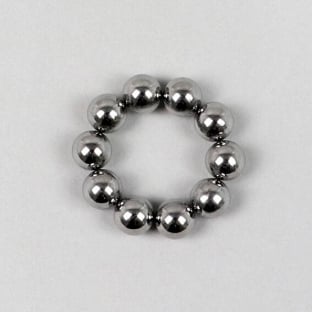
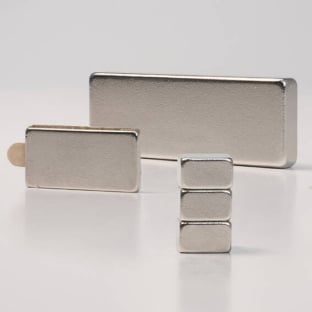
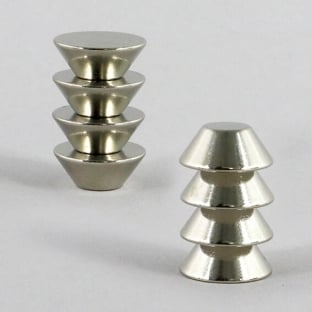
.jpg)
